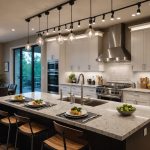Benefits of Adjustable Track Lighting in the Kitchen
Adjustable track lighting offers a myriad of advantages in kitchen spaces. The flexibility it provides in light direction is particularly practical for enhancing the visual appeal of food. By focusing light on prepared dishes or specific areas, the adjustable track lighting benefits chefs and diners alike, creating an inviting dining experience.
Flexibility in lighting positions contributes significantly to the overall kitchen ambiance. Unlike fixed lighting, adjustable tracks can accommodate various tasks and activities. Whether you’re chopping vegetables or hosting a dinner party, these systems allow you to easily modify the light setting to suit any occasion. This adaptability adds to the kitchen lighting advantages, making it a popular choice for modern homes.
Moreover, modern track lighting stands out for its energy efficiency and cost-effectiveness. With advancements in LED technology, these systems consume less power and have a longer lifespan compared to traditional options. Hence, homeowners not only enjoy enhanced lighting conditions but also observe a reduction in their electricity bills. The sustainable nature of these lights is an added bonus, aligning with environmentally conscious living.
In summary, adjustable track lighting is an invaluable addition to any kitchen, offering control, ambiance, and efficiency.
Enhancing Meal Presentation with Lighting
Food presentation lighting can significantly elevate the dining experience by enhancing meal aesthetics. The interplay of light and food is an art that can transform culinary creations into visual masterpieces.
The Role of Color Temperature
Color temperature is crucial in food presentation lighting. It affects how the colours of a dish are perceived. Cooler lighting can make dishes appear more clinical, whereas warmer lighting can enhance the natural hues, making food look more appetising. Chefs often choose warm tones to complement the rich colours of meats and vegetables, making meals more appealing to diners.
Highlighting Key Dishes
Strategically directed lighting can spotlight key dishes on a dining table. By focusing light on centerpieces, attention is drawn to the meals intended to be the highlight of the experience. This technique not only makes dishes stand out but also guides the visual journey of a diner, ensuring each creation is appreciated.
Creating Mood with Lighting
The brightness and warmth of lights can create varying atmospheres, affecting the dining experience. Warmer tones evoke a cosy ambiance, while dimmed lights can create a romantic or intimate setting. Adjusting the brightness allows for a dynamic environment, matching the desired theme or mood for a meal.
Strategic Lighting Placement
Creating an inviting and functional kitchen starts with effective lighting placement. When designing your kitchen, it’s crucial to focus on strategic areas like countertops, the dining table, and open shelves. These zones benefit immensely from targeted lighting, enhancing both aesthetics and utility.
Countertops are one of the most actively used spaces. Therefore, placing lights directly above can minimise shadows and make preparation tasks more efficient. Choosing the right fixtures plays an important role in the overall kitchen design, as it ensures visibility without creating glare.
For the dining table, opting for adjustable pendant lights allows you to alter the ambiance and cater to different occasions. This ensures you maintain a warm atmosphere whether it’s a casual meal or a formal dinner.
Open shelves are excellent for showcasing items. Installing LED strips beneath or above these shelves elevates the entire kitchen’s look and highlights your treasured cookbooks or decorative pieces.
Remember, layering light sources adds depth and dimension to your kitchen. Mixing ambient, task, and accent lighting creates a well-balanced space where functionality meets style. This cohesive approach to lighting placement can transform any kitchen into an inviting and efficient culinary haven.
Impact on Portion Control
The psychological impact of lighting on perceived portion sizes is noteworthy. Dim lighting can make food appear more abundant, potentially leading to over-serving and over-eating. Conversely, bright, well-placed lighting can emphasize the actual portion, aiding in better evaluation of appropriate serving sizes. This is connected to portion control lighting, which leverages light to enhance awareness about food intake.
Nutrition and visual cues are deeply intertwined. Visual cues provided by lighting can highlight specific features of a meal, such as its size or nutrient density, which may encourage mindful eating. When lighting is strategically used, it can help diners focus on the food in a manner that promotes clarity in decision-making regarding portions.
Furthermore, using lighting to direct attention to serving sizes offered can influence dietary choices significantly. For example:
-
Bright lights can make smaller portions more enticing, often leading individuals to savour each bite consciously.
-
Strategic portion control lighting emphasizes appropriate serving sizes, reducing the likelihood of overindulgence.
Therefore, harnessing lighting as a tool for portion control can be an effective strategy to promote healthier eating habits and facilitate a more mindful dining experience.
Design Aesthetics of Track Lighting
The right choice of track lighting can elevate any modern kitchen design, providing both functional and aesthetic lighting solutions. By integrating track lighting seamlessly with your kitchen decor, you can achieve a harmonious blend that not only enhances visibility but also complements the overall ambiance.
Integrating Track Lighting with Kitchen Decor
Track lighting offers great flexibility in installation, making it a favourite for modern kitchen designs. When integrating it into your kitchen decor, consider how the lighting fixtures align with other design elements. From your cabinetry to your countertops, every feature should form a cohesive narrative with your lighting choice.
Choosing the Right Fixtures
Selecting the appropriate fixtures requires consideration of both style and function. The fixtures should not only cater to your lighting needs but also reflect your kitchen’s aesthetic. Choices range from sleek minimalist designs to more robust industrial styles, each offering unique characteristics that can enhance the culinary space.
Trends in Kitchen Lighting Design
Current trends in kitchen lighting favour minimalist and industrial designs, marked by clean lines and simple forms. Variations in materials such as metal and glass, along with diverse finishes, allow for customization that resonates with personal taste. By aligning fixture styles with your overall kitchen theme, you ensure that your lighting enhances the design narrative.
Practical Tips for Installation and Maintenance
When it comes to track lighting installation, embarking on a DIY project can be rewarding if approached with clear guidance. First and foremost, ensure the power is turned off at the circuit breaker before starting to work with any electrical fixtures. This is crucial for safety.
For a smooth installation, gather necessary tools such as a drill, screwdriver, and voltage tester. Begin by marking the spot on the ceiling where the track will be affixed, and use the voltage tester to double-check no electricity is flowing through the wires. Following these essential steps can greatly smooth out the installation process.
Once installed, adopting maintenance tips is vital for ensuring your lighting system operates efficiently. Regularly clean the track and light fixtures with a dry cloth to prevent dust build-up. This not only maintains the aesthetic appeal but also optimizes the light output.
Inspect the connections frequently for any signs of wear or loose fittings. While track lighting is generally low-maintenance, taking these steps will contribute to its longevity. Adhering to these best practices guarantees a safe, effective, and enduring lighting solution in your home.











